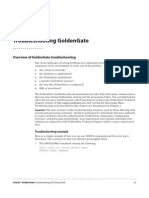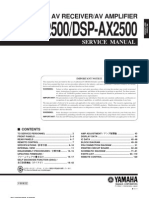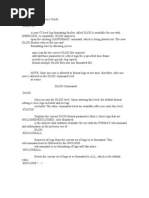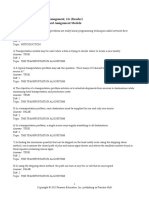0 ratings0% found this document useful (0 votes)
51 viewsOracle-12c Configure Step by Step Goldengate Unidirectional Method
Oracle-12c Configure Step by Step Goldengate Unidirectional Method
Uploaded by
Nuhu Magwai1. The document describes how to configure Oracle GoldenGate 12c for unidirectional data replication from a source Oracle 12c database to a target Oracle 12c database.
2. The process involves installing GoldenGate, setting up extract and replicat processes on the source and target databases respectively, and starting the replication processes to synchronize data between the databases.
3. Key components include the manager, extract, datapump, and replicat processes, as well as parameter files, trails, and other configuration settings required to set up and monitor the replication.
Copyright:
© All Rights Reserved
Available Formats
Download as DOCX, PDF, TXT or read online from Scribd
Oracle-12c Configure Step by Step Goldengate Unidirectional Method
Oracle-12c Configure Step by Step Goldengate Unidirectional Method
Uploaded by
Nuhu Magwai0 ratings0% found this document useful (0 votes)
51 views12 pages1. The document describes how to configure Oracle GoldenGate 12c for unidirectional data replication from a source Oracle 12c database to a target Oracle 12c database.
2. The process involves installing GoldenGate, setting up extract and replicat processes on the source and target databases respectively, and starting the replication processes to synchronize data between the databases.
3. Key components include the manager, extract, datapump, and replicat processes, as well as parameter files, trails, and other configuration settings required to set up and monitor the replication.
Original Description:
Oracle-12c Configure Step by step Goldengate Unidirectional Method
Original Title
Oracle-12c Configure Step by step Goldengate Unidirectional Method
Copyright
© © All Rights Reserved
Available Formats
DOCX, PDF, TXT or read online from Scribd
Share this document
Did you find this document useful?
Is this content inappropriate?
1. The document describes how to configure Oracle GoldenGate 12c for unidirectional data replication from a source Oracle 12c database to a target Oracle 12c database.
2. The process involves installing GoldenGate, setting up extract and replicat processes on the source and target databases respectively, and starting the replication processes to synchronize data between the databases.
3. Key components include the manager, extract, datapump, and replicat processes, as well as parameter files, trails, and other configuration settings required to set up and monitor the replication.
Copyright:
© All Rights Reserved
Available Formats
Download as DOCX, PDF, TXT or read online from Scribd
Download as docx, pdf, or txt
0 ratings0% found this document useful (0 votes)
51 views12 pagesOracle-12c Configure Step by Step Goldengate Unidirectional Method
Oracle-12c Configure Step by Step Goldengate Unidirectional Method
Uploaded by
Nuhu Magwai1. The document describes how to configure Oracle GoldenGate 12c for unidirectional data replication from a source Oracle 12c database to a target Oracle 12c database.
2. The process involves installing GoldenGate, setting up extract and replicat processes on the source and target databases respectively, and starting the replication processes to synchronize data between the databases.
3. Key components include the manager, extract, datapump, and replicat processes, as well as parameter files, trails, and other configuration settings required to set up and monitor the replication.
Copyright:
© All Rights Reserved
Available Formats
Download as DOCX, PDF, TXT or read online from Scribd
Download as docx, pdf, or txt
You are on page 1of 12
Oracle-12c Configure Step by step
Goldengate Unidirectional Method
Oracle-12c Configure Step by step Goldengate Unidirectional
Method
Description:-
In oracle goldengate unidirectional configuration allows data workflow in
one direction, from source to target only. Source system goldengate extract
group capture the changes information from either redo log files or
archivelog and forward Oracle goldenGate trails to the remote system. And
replication group apply the transactions to the target database keeping the
two databases synchronized.
Replication between two databases requires the setting up of the Manager,
Extract and Pump processes on the source database and setting up the
Manager and Replicat processes on the target database.
MANAGER: Runs on all servers involved in the replication. It is the master
process which controls all GG activity.
EXTRACT: Runs on the source database server. It extracts data from the
Oracle database either directly or indirectly in the case of Integrated
capture.
DATAPUMP: Runs on the source database server. It is an optional process
which transmits extracted data from the source database server to the
target database server. (Optional because the EXTRACT process can do
this directly).
SERVER COLLECTOR: Runs on the target database server. Receives
extracted data from source database server and stages it in the local trail
files on the target database server for the REPLICAT process to apply it to
the target database.
REPLICAT: Runs on the target database server. Reads extracted data
from the local trail file on the target database server and applies the data to
the target database.
Installing Oracle 12.2 GoldenGate on Linux server Here
Oracle-12c Configure Step By Step Goldengate Bidirectional Method Here
Source Database
Hostname : ggsource.doyensys.com
Oracle database SID: GGSOURCE
Oracle version: 12.2.0
Oracle GG version: 12.2.0
Target Database
Hostname : ggtarget.doyensys.com
Oracle database SID: GGTARGET
Oracle version: 12.2.0
Oracle GG version: 12.2.0
Check the connectivity from source to target for replication.
Both source and target side add the host information to /etc/hosts file.
On source(ggsource.doyensys.com) verify that LOG_MODE is set
to ARCHIVELOG.
Archivelog must be enable on source side because if we are using classic
capture the extract process will capture the changes information through
archivelogs only, So it is mandatory for classic capture replication.
select LOG_MODE from v$database;
shu immediate;
startup mount;
ALTER DATABASE ARCHIVELOG;
alter database open;
select LOG_MODE from v$database;
Verify that supplemental logging and forced logging are set properly.
ALTER DATABASE FORCE LOGGING;
ALTER DATABASE ADD SUPPLEMENTAL LOG DATA;
select SUPPLEMENTAL_LOG_DATA_MIN,FORCE_LOGGING from
v$database;
This parameter must be changed on source and target databases:
ALTER SYSTEM SET ENABLE_GOLDENGATE_REPLICATION=TRUE
SCOPE=BOTH;
show parameter ENABLE_GOLDENGATE_REPLICATION
Create the administrator and user/schema owners on both source and
target database.
create user gguser identified by gguser default tablespace goldengate
quota unlimited on goldengate;
grant create session,connect,resource,alter system to gguser;
EXEC
DBMS_GOLDENGATE_AUTH.GRANT_ADMIN_PRIVILEGE(grantee=>’gg
user’, privilege_type=>’CAPTURE’, grant_optional_privileges=>’*’);
Go to Golden Gate Installed location (in our scenario /u01/gghome)
and then run the following Golden Gate inbuild scripts for creating all
necessary objects to support DDL replication.
1. @marker_setup
2. @ddl_setup
3. @role_setup.sql
4. GRANT GGS_GGSUSER_ROLE TO <loggedUser>
5. @ddl_enable.sql
Start GGSCI and login into database using dblogin command.
dblogin userid gguser, password gguser
By default manager parameter has created while installing the
goldengate software we just add the user information to manager
parameter file.
PORT 7811
USERIDALAIS gguser
Check the manager parameter and status.
view param mgr
Source side add trandata for particular table which we wants to
replicate the data to target database.
add tranadata demo.*
Create the primary Extract parameter file.
EXTRACT ext1
USERID gguser@ggsource, PASSWORD gguser
EXTTRAIL /u01/gghome/dirdat/aa
DDL INCLUDE ALL
TABLE demo.*;
Create the Extract group and the local Extract trail file and start the
extract process.
add extract ext1 tranlog begin now
add exttrail /u01/gghome/dirdat/aa extract ext1
start extract ext1
Check the status of primary extract process.
info ext1
Create the secondary Extract (data pump) parameter file.
EXTRACT dpump1
USERID gguser@ggsource, PASSWORD gguser
RMTHOST ggtarget, MGRPORT 7810
RMTTRAIL /u01/gghome/dirdat/ab
DDL INCLUDE ALL
TABLE demo.*;
Create the data pump group and the remote Extract trail file and start
the data pump process.
add extract dpump1 exttrailsource /u01/gghome/dirdat/aa
add rmttrail /u01/gghome/dirdat/ab extract dpump1
start extract dpump1
To check the status of data pump process.
info dpump1
TARGET (GGTARGET.DOYENSYS.COM):
Start GGSCI and login into database using dblogin command.
./ggsci
dblogin userid gguser password gguser
To check the manager status on target server.
view param mgr
info mgr
To create a checkpoint Table in the target database.
add checkpointtable gguser.chkpt
info checkpointtable gguser.chkpt
Create the Replicat parameter file.
REPLICAT rep1
USERID gguser@ggtarget, PASSWORD gguser
DDL INCLUDE ALL
DDLERROR DEFAULT IGNORE
MAP demo.*, TARGET demo.*;
Create and start the replicat process.
add replicat rep1 exttrail /u01/gghome/dirdat/ab checkpointtable
gguser.chkpt
start replicat rep1
To check the status of replicat process.
info rep1
To check the replication from source to target database.
Create one sample table and generate insert operation into that table.
Verify that the table and rows were replicated into the target database.
You might also like
- Suzuki - Master Tech M22-3EDocument102 pagesSuzuki - Master Tech M22-3Esebprox1No ratings yet
- Windows 2019 Failover Cluster Step by StepDocument8 pagesWindows 2019 Failover Cluster Step by StepNuhu MagwaiNo ratings yet
- Original Texts For Demo EditsDocument7 pagesOriginal Texts For Demo EditsIvana JeremicNo ratings yet
- Match The Words (1-7) With The Definitions (A-G)Document4 pagesMatch The Words (1-7) With The Definitions (A-G)ВикторияNo ratings yet
- Step by Step Golden GateDocument27 pagesStep by Step Golden GatebillNo ratings yet
- RAC-ASM-VOTING DISK Interview Questions & AnswerDocument18 pagesRAC-ASM-VOTING DISK Interview Questions & AnswerNuhu Magwai100% (1)
- Golden GateDocument18 pagesGolden GateANKIT GOYALNo ratings yet
- Oracle GoldenGate Basic ArchitectureDocument24 pagesOracle GoldenGate Basic Architecturesanjayid1980100% (1)
- GoldenGate Integrated Capture ModeDocument3 pagesGoldenGate Integrated Capture ModeMohammad MazheruddinNo ratings yet
- Oracle Golden GateDocument21 pagesOracle Golden GateKousik BhattacharyaNo ratings yet
- Oracle Goldengate Concepts and ArchitectureDocument23 pagesOracle Goldengate Concepts and ArchitectureIan HughesNo ratings yet
- Golden GateDocument9 pagesGolden Gatevirkz.gaganNo ratings yet
- GoldenGate - Setup Bi-Directional Replication in Multitenant EnvironmentDocument15 pagesGoldenGate - Setup Bi-Directional Replication in Multitenant EnvironmentNuhu MagwaiNo ratings yet
- GoldenGate POCDocument13 pagesGoldenGate POCRathinavel SubramaniamNo ratings yet
- Goldengate ReplicationDocument12 pagesGoldengate ReplicationAbdelmadjid BouamamaNo ratings yet
- OGG Pratical Reference DocDocument17 pagesOGG Pratical Reference Docsreeharirao kadaliNo ratings yet
- Oracle GoldenGate NotesDocument9 pagesOracle GoldenGate NotesabishekvsNo ratings yet
- Oracle Goldengate Classic ArchitectureDocument14 pagesOracle Goldengate Classic Architecturelehuuthang1752No ratings yet
- Oracle GoldenGateDocument44 pagesOracle GoldenGateGovinda GallaNo ratings yet
- 11 G Golden GateDocument20 pages11 G Golden Gateguru181818No ratings yet
- Golden Gate OracleDBCloud MySQLCloudDocument8 pagesGolden Gate OracleDBCloud MySQLCloudTran Quoc DungNo ratings yet
- Oracle Scene 63 N Chandler Getting Started With Oracle GoldengateDocument7 pagesOracle Scene 63 N Chandler Getting Started With Oracle GoldengateAshrNo ratings yet
- Integrated Replicat GoldenGate 12c New FeatureDocument8 pagesIntegrated Replicat GoldenGate 12c New FeaturesharmaNo ratings yet
- 03A IntegratedMode DML Replication Using Goldengate 12c Multitenant Architecture StepsDocument4 pages03A IntegratedMode DML Replication Using Goldengate 12c Multitenant Architecture StepssharmaNo ratings yet
- Oracle® Goldengate: Tutorial For Oracle To OracleDocument19 pagesOracle® Goldengate: Tutorial For Oracle To OracleNainika KedarisettiNo ratings yet
- Index 1. Two. Three. April. MayDocument18 pagesIndex 1. Two. Three. April. MayMabu DbaNo ratings yet
- Schema Replication Using Oracle GoldengateDocument7 pagesSchema Replication Using Oracle GoldengateMohamed Fowjil Abdul HameedNo ratings yet
- Schedule: Timing Topic: 30 Minutes 50 Minutes Practice 80 Minutes TotalDocument115 pagesSchedule: Timing Topic: 30 Minutes 50 Minutes Practice 80 Minutes TotalCacobitoNo ratings yet
- Oracle Golden Gate Interview QuestionsDocument37 pagesOracle Golden Gate Interview Questionsganjigirish100% (1)
- 06A-INITIAL LOAD-GG 12c Multitenant ArchitectureDocument3 pages06A-INITIAL LOAD-GG 12c Multitenant ArchitectureMohammad MazheruddinNo ratings yet
- Configuring Oracle Goldengate Ogg 11Gr2 Downstream Integrated CaptureDocument16 pagesConfiguring Oracle Goldengate Ogg 11Gr2 Downstream Integrated CapturepemgNo ratings yet
- WP OGG Best Practices Parameter FilesDocument7 pagesWP OGG Best Practices Parameter Filesjunk emailNo ratings yet
- Oraclegg Part3 TroubleDocument41 pagesOraclegg Part3 TroubleScribd_441No ratings yet
- Oracle BI Applications 11g GoldenGate IntegrationDocument19 pagesOracle BI Applications 11g GoldenGate IntegrationPraveenNo ratings yet
- OGG HandsOnLabDocument11 pagesOGG HandsOnLabnt29No ratings yet
- Goldan GateDocument4 pagesGoldan GatemnsamysureshNo ratings yet
- DBA - Oracle Golden Gate 12 - Bidirectional Replication - ActivDocument14 pagesDBA - Oracle Golden Gate 12 - Bidirectional Replication - Activwish_newNo ratings yet
- ORACLE To Oracle Replication Through Golden Gate 3Document8 pagesORACLE To Oracle Replication Through Golden Gate 3SSABEENNo ratings yet
- Patching Oracle Database Physical Standby With Enterprise Manager 12cDocument5 pagesPatching Oracle Database Physical Standby With Enterprise Manager 12caibot aibotNo ratings yet
- Upgrading Oracle Goldengate AdaptersDocument5 pagesUpgrading Oracle Goldengate AdaptersDomenico ConteNo ratings yet
- SAP Database RefereshDocument58 pagesSAP Database Refereshleninsrinu9100% (2)
- Defining Multiple Replicats To Increase GoldenGate PerformanceDocument6 pagesDefining Multiple Replicats To Increase GoldenGate PerformancebugzbinnyNo ratings yet
- Goldengate Encryption WalletDocument8 pagesGoldengate Encryption Walletmanoj2904kumar.mNo ratings yet
- MSSQL To Oracle ZDU Migration With Oracle GoldenGate 12.3Document9 pagesMSSQL To Oracle ZDU Migration With Oracle GoldenGate 12.3Tran Quoc DungNo ratings yet
- DataPumpDocument12 pagesDataPumpMohammad NizamuddinNo ratings yet
- GoldenGate 5226286940 260917 1336 662Document23 pagesGoldenGate 5226286940 260917 1336 662Tran Quoc DungNo ratings yet
- Golden Gate DocumentDocument10 pagesGolden Gate Documentmasheed ullahNo ratings yet
- Oracle 19c - Complete Checklist For Manual Upgrade For Upgrading Oracle 12.x, 18c Container - 2549866.1Document13 pagesOracle 19c - Complete Checklist For Manual Upgrade For Upgrading Oracle 12.x, 18c Container - 2549866.1Lin LiNo ratings yet
- Oracle GoldenGate Pocket Reference-NSMDocument4 pagesOracle GoldenGate Pocket Reference-NSMdineshnanidba100% (2)
- Ggs Sybase To OraDocument16 pagesGgs Sybase To OraThota Mahesh DbaNo ratings yet
- Golden Gate Oracle ReplicationDocument3 pagesGolden Gate Oracle ReplicationCynthiaNo ratings yet
- 11g Data Guard New Features: - Fan XiangrongDocument26 pages11g Data Guard New Features: - Fan XiangrongdivyeshswetaNo ratings yet
- Oracle Handy CommandsDocument14 pagesOracle Handy CommandsPadmashali KumarNo ratings yet
- Maa GG Performance 1969630Document51 pagesMaa GG Performance 1969630sjkhappsNo ratings yet
- How To Install and Configure Oracle Golden GateDocument12 pagesHow To Install and Configure Oracle Golden GatesadineniNo ratings yet
- GoldenGate Tutorial 1Document4 pagesGoldenGate Tutorial 1niaam100% (1)
- Bi-Directional Replication: With Conflict Detection and Resolution (CDR) Using Oracle Goldengate 12CDocument25 pagesBi-Directional Replication: With Conflict Detection and Resolution (CDR) Using Oracle Goldengate 12CNainika KedarisettiNo ratings yet
- HOL 18c Upgrade - Upgrade Your Database: From Oracle 11.2.0.4 To Oracle 18.2.0Document7 pagesHOL 18c Upgrade - Upgrade Your Database: From Oracle 11.2.0.4 To Oracle 18.2.0Bi BôngNo ratings yet
- Oracle Golden Gate Learning GuideDocument129 pagesOracle Golden Gate Learning GuiderethinakumarsNo ratings yet
- Golden Gate - Online Change Synchronization With The Initial Data LoadDocument5 pagesGolden Gate - Online Change Synchronization With The Initial Data LoadPujan Roy100% (1)
- Goldengate Deployment in A A Rac Infrastructure: Brookhaven National Laboratory, UsDocument10 pagesGoldengate Deployment in A A Rac Infrastructure: Brookhaven National Laboratory, UstonNo ratings yet
- Cloning Oracle Transportation Management Database Schemas For 6.4.3 (Doc ID 2593800.1)Document7 pagesCloning Oracle Transportation Management Database Schemas For 6.4.3 (Doc ID 2593800.1)Sreekar PamuNo ratings yet
- Oracle 10g Dataguard Best Practice and Setup StepsDocument6 pagesOracle 10g Dataguard Best Practice and Setup Stepsborra venkateshNo ratings yet
- Oracle GoldenGate 11g Implementer's guide: Design, install, and configure high-performance data replication solutions using Oracle GoldenGateFrom EverandOracle GoldenGate 11g Implementer's guide: Design, install, and configure high-performance data replication solutions using Oracle GoldenGateNo ratings yet
- ASMCMD Commands For Oracle ASM ManagementDocument8 pagesASMCMD Commands For Oracle ASM ManagementNuhu MagwaiNo ratings yet
- Mastering Essential ASM OperationsDocument21 pagesMastering Essential ASM OperationsNuhu MagwaiNo ratings yet
- Scheduling Jobs in Oracle DB With DBMS - SCHEDULERDocument9 pagesScheduling Jobs in Oracle DB With DBMS - SCHEDULERNuhu MagwaiNo ratings yet
- GoldenGate - Setup Bi-Directional Replication in Multitenant EnvironmentDocument15 pagesGoldenGate - Setup Bi-Directional Replication in Multitenant EnvironmentNuhu MagwaiNo ratings yet
- OSDS-Multiple Choice QuestionsDocument39 pagesOSDS-Multiple Choice QuestionsNuhu Magwai100% (1)
- Oracle-Change The Name and Dbid of The DatabaseDocument4 pagesOracle-Change The Name and Dbid of The DatabaseNuhu MagwaiNo ratings yet
- Active Directory: ReplicationDocument8 pagesActive Directory: ReplicationNuhu MagwaiNo ratings yet
- Typical Questions & AnswersDocument82 pagesTypical Questions & AnswersSudip PaulNo ratings yet
- Rman Backup and Recovery Practice Duplicate Database: Alejandro Vargas February 4, 2007Document13 pagesRman Backup and Recovery Practice Duplicate Database: Alejandro Vargas February 4, 2007kthimmaNo ratings yet
- Using RMAN To Perform RecoveryDocument32 pagesUsing RMAN To Perform RecoveryNuhu MagwaiNo ratings yet
- The Motherboard: A Look at The Brains of The Computer, The Motherboard, and Its Associated ComponentsDocument36 pagesThe Motherboard: A Look at The Brains of The Computer, The Motherboard, and Its Associated ComponentsNuhu MagwaiNo ratings yet
- MCI Engagements - Partner Activities - Partner Center Claims Guide (2024-07-01)Document61 pagesMCI Engagements - Partner Activities - Partner Center Claims Guide (2024-07-01)Mina SaneedNo ratings yet
- Guide To The Benefits of SD-WAN12Document6 pagesGuide To The Benefits of SD-WAN12asdasasdsadNo ratings yet
- Operations Management: Operations Strategy in A Global EnvironmentDocument62 pagesOperations Management: Operations Strategy in A Global EnvironmentRey KardionoNo ratings yet
- Analog ElectronicsDocument36 pagesAnalog ElectronicsThirumalesh BNo ratings yet
- An Investigation Into Web Services A Case of An Online Reservation SystemDocument57 pagesAn Investigation Into Web Services A Case of An Online Reservation SystempaghiliganalexisNo ratings yet
- Curtis Battery Indicator 906Document3 pagesCurtis Battery Indicator 906Mirko CoppiniNo ratings yet
- AS-1.1 With NamesDocument2 pagesAS-1.1 With NamesJosh DesuyoNo ratings yet
- WR CAPF ACs EXAM 2021 131021 Engl RollDocument6 pagesWR CAPF ACs EXAM 2021 131021 Engl RollVikas MishraNo ratings yet
- Yamaha rx-v2500 Dsp-Ax2500 SM (ET)Document119 pagesYamaha rx-v2500 Dsp-Ax2500 SM (ET)Oscar Blasco BuitragoNo ratings yet
- SD Fi Copa Reconciliation Part 2Document18 pagesSD Fi Copa Reconciliation Part 2BAble996No ratings yet
- BGC-8088 Microengineer SpecificationDocument2 pagesBGC-8088 Microengineer SpecificationJarinNo ratings yet
- Accelerating Edge AI With Morpher: An Integrated Design, Compilation and Simulation Framework For CgrasDocument5 pagesAccelerating Edge AI With Morpher: An Integrated Design, Compilation and Simulation Framework For CgrasGJNo ratings yet
- GM Offer Letter-Himanshu Deep - FinanceF4Document2 pagesGM Offer Letter-Himanshu Deep - FinanceF4TrunkheaDNo ratings yet
- Vehicle Breakdown Assistance Management System With Insurance Using PHPDocument9 pagesVehicle Breakdown Assistance Management System With Insurance Using PHPThioder EugineNo ratings yet
- s7200 Data SheetDocument3 pagess7200 Data SheetVamsi KumarNo ratings yet
- March 2006Document150 pagesMarch 2006api-3750896100% (3)
- DLOG Quick Reference GuideDocument4 pagesDLOG Quick Reference GuidejojunatasNo ratings yet
- Simulation ACtivity 4.3 THE SMALL SIGNAL AMPLIFIER SimulationDocument16 pagesSimulation ACtivity 4.3 THE SMALL SIGNAL AMPLIFIER SimulationKarl Vincent BebingNo ratings yet
- Quik User GuideDocument4 pagesQuik User Guidehonanak731No ratings yet
- LogDocument12 pagesLogJonathan EstayNo ratings yet
- Ketki ZaveriDocument2 pagesKetki Zaveriapi-15368277100% (2)
- FS2 L5 Direct-Proportion Slides Final 2Document31 pagesFS2 L5 Direct-Proportion Slides Final 2Back To DecemberNo ratings yet
- Mathematics Year 4 Paper 1 September 2009Document7 pagesMathematics Year 4 Paper 1 September 2009BadNo ratings yet
- Project Ideas For StudentsDocument12 pagesProject Ideas For StudentsPreeti KherNo ratings yet
- ALUMINUM BLADE PG 1 - 60Document59 pagesALUMINUM BLADE PG 1 - 60ramis cuspNo ratings yet
- Chapter 9 Transportation and Assignment Models: Quantitative Analysis For Management, 11e (Render)Document30 pagesChapter 9 Transportation and Assignment Models: Quantitative Analysis For Management, 11e (Render)Jay BrockNo ratings yet
- ECE510: Digital Hardware Design (DHD)Document29 pagesECE510: Digital Hardware Design (DHD)Romesh RajoriaNo ratings yet





































































































